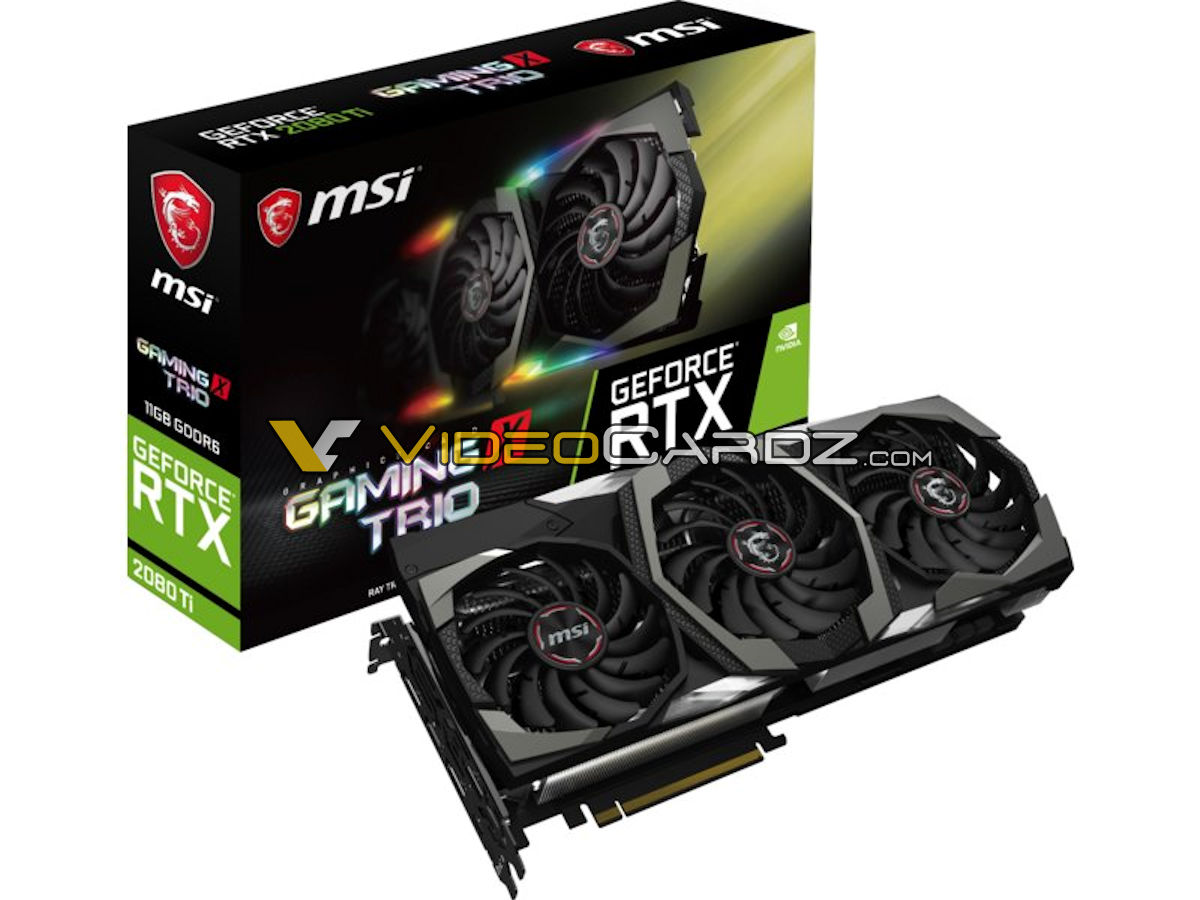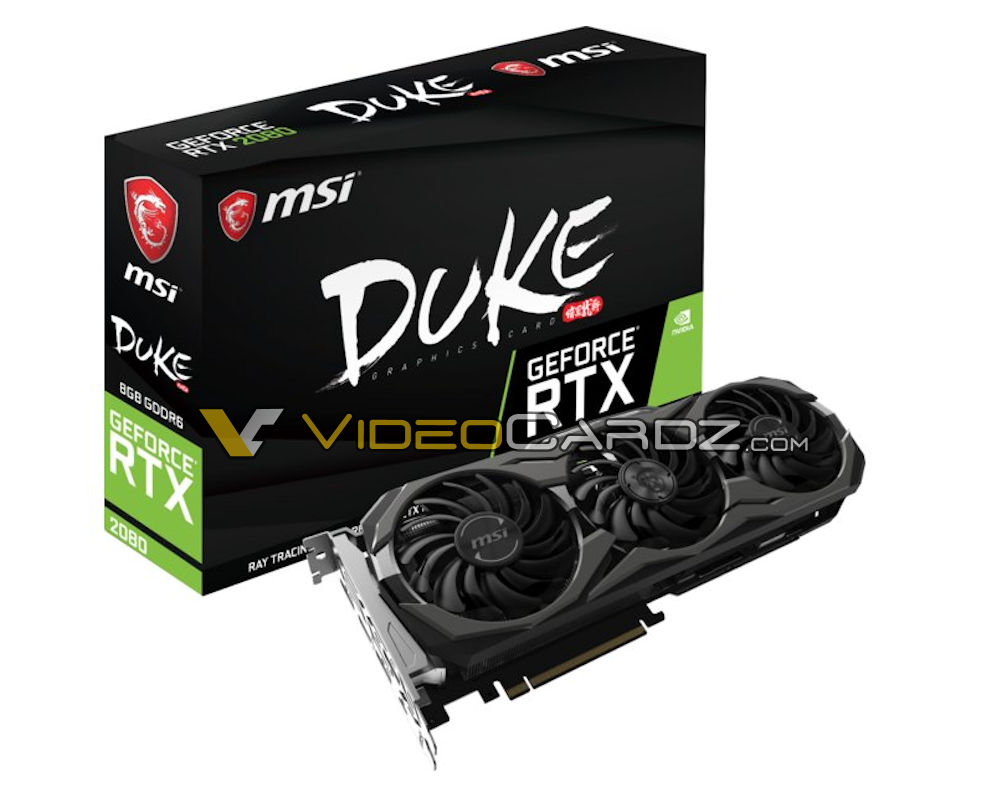MSI GeForce RTX 2080 & 2080 Ti GPUs Smile for the Camera
Images of the MSI GeForce RTX 2080 and RTX 2080 Ti Gaming X Trio and Duke graphics cards have appeared in the wild three days before their expected launch.
Nvidia's next-generation graphics cards are rumored to launch on August 20 at Gamescom in Cologne, Germany. As it happens with every major graphics card launch, leaked images of the unannounced models have started to surface over the internet. On this occasion, VideoCardz has reportedly leaked images of MSI's upcoming GeForce RTX 2080 and RTX 2080 Ti from the company's Gaming X and Duke series.
MSI GeForce RTX 2080 & 2080 Ti Gaming X Trio




According to the leaked images, the GeForce RTX 2080 and RTX 2080 Ti Gaming X Trio inherit the characteristic Tri Frozr triple-fan cooling solution present on previous Gaming X Trio models. Therefore, they should occupy up to three PCI slots in a case. However, MSI did make several minor changes to the Tri Frozr cooler itself.
For starters, the body now features a black and gray theme that resembles a carbon fiber finish. Aficionados of the brand will be happy to know that MSI has replaced the red LED strips with customizable RGB lighting on both sides of the graphics card so it blends effortlessly into any build.
The manufacturer has switched up the order of the fans on the Tri Frozr cooler a bit as well. In past models, the middle 90mm fan was sandwiched between the two larger 100mm fans. For the RTX 2080 & 2080 Ti Gaming X Trio, MSI placed the 90mm in front, which does make the design look a little unorthodox. Although judging by its design, these should be the same 14-blade Torx 2.0 fans that MSI is so fond of using in its graphics cards. We can expect them to come with the brand's Zero Frozr technology, which would basically keeps the fans off until the GPU's temperature hits 140°F (60°C). The RTX 2080 Ti Gaming X Trio also flaunts a sleek, silver, brushed aluminum backplate.
In addition to the PCIe lane, the RTX 2080 Ti Gaming X Trio appears to draw its power from two eight-pin PCIe power connectors, which means it can pull up to 375W. Unfortunately, the PCIe connectors are not visible on the RTX 2080 model but it should come with a six-pin and eight-pin PCIe connectors. In terms of video outputs, the graphics cards come equipped with three DisplayPort outputs, one USB Type-C port (VirtualLink), and possibly an HDMI port.. It seems Nvidia has finally decided to stop using SLI connectors, with both graphics cards utilizing NVLink instead.
Get Tom's Hardware's best news and in-depth reviews, straight to your inbox.
MSI GeForce RTX 2080 & 2080 Ti Duke




In terms of aesthetics, the MSI GeForce RTX 2080 and 2080 Ti Duke graphics cards look like they'll carry a toned-down version of the Tri Frozr cooler. If MSI utilized a similar design as previous Duke models, then the RTX 2080 and 2080 Ti Duke should only require two PCI slots for installation. The cooler employs a trio of same-sized 100mm 14-blade Torx 2.0 fans with Zero Frozr technology. However, it lacks flash compared to the the Gaming X Trio models. Nevertheless, the RTX 2080 and 2080 Ti Duke do have their own RGB LED bar on the side and a cool full-cover metallic backplate. The MSI RTX 2080 and 2080 Ti Duke are expected to use the same combination of PCIe connectors as the Gaming X Trio models.
The rumored specifications for the RTX 2080 and RTX 2080 Ti indicate that both graphics cards are based on the Turing architecture and manufactured under TSMC's 12nm FinFET process. The RTX 2080 features the TU104 silicon and comes with 2944 shading units, 192 TMUs (texture mapping units), 64 ROPs (render output units), 24 SMs (streaming multiprocessors) and 384 tensor cores. It's clocked at 1,515MHz with a boost clock that escalates to 1,750MHz. There is 8GB of GDDR6 memory onboard operating at 14GHz across a 256-bit memory interface. The RTX 2080 has a 200W TDP (thermal design power) rating.
As for the RTX 2080 Ti, this model purportedly utilizes the TU102 silicon. The RTX 2080 Ti possesses 4,352 shading units, 272 TMUs, 88 ROPs, 68 SMs and 576 tensor cores. It has a base clock of 1,350MHz and a boost clock in the range of 1,500MHz. The graphics card's 11GB of GDDR6 memory comes in at 14GHz across a 352-bit memory bus. The RTX 2080 Ti features a 250W TDP rating.

Zhiye Liu is a news editor, memory reviewer, and SSD tester at Tom’s Hardware. Although he loves everything that’s hardware, he has a soft spot for CPUs, GPUs, and RAM.
-
AgentLozen So this is implying that Nvidia will lead with the 2080Ti? In the case of Kepler, Maxwell, and Pascal, the 780, 980, and 1080 cards came out first followed by the Ti model a year later.Reply -
sizzling If not fake then my guess would be we will see a 2090 or 2090Ti in 9 months after the 2080Ti. It just makes too much sense financially to release the best card later.Reply -
none12345 "So this is implying that Nvidia will lead with the 2080Ti? In the case of Kepler, Maxwell, and Pascal, the 780, 980, and 1080 cards came out first followed by the Ti model a year later."Reply
It depends what they release. I have a strong feeling that they are doing a 12nm large die for a new xx80ti and titan. Then everything else is going to be a rebrand of existing chips(the old 1080ti die is the new xx80, the old 1080 die is the new 1070 and 1060 etc). If that's true....it makes perfect sense to lead with the new xx80ti.
With the crash of crypto, the supposed overstock of pascal dies, as well as 7nm not being ready yet.....it would make a whole lot of sense to make 1(maybe 2) new die on 12nm(which is really just 16nm with a larger reticle limit) for the high end, and then rebrand everything else for the other segments.
I am not saying this is what they are going to do, just what i think they will do. -
bugnguts An early 2080ti release makes sense because nVIDIA is caught in a bit of a bind. The cryptocurrency boom and lack of significant competition from team Red gave them little reason for an earlier refresh. The problem is they milked the situation a little too long, 2 years. 7nm manufacturing has begun and within a year the process will be mature enough for good yields on large GPU/RTU dies. If they waited the normal 9 months for the ti release it would overlap next-generation chips that can easily have 50% higher transistor count. Instead, they release it now and still get sales from the enthusiast segment now and again when 3080 on 7nm node.Reply -
JamesSneed Reply21240650 said:An early 2080ti release makes sense because nVIDIA is caught in a bit of a bind. The cryptocurrency boom and lack of significant competition from team Red gave them little reason for an earlier refresh. The problem is they milked the situation a little too long, 2 years. 7nm manufacturing has begun and within a year the process will be mature enough for good yields on large GPU/RTU dies. If they waited the normal 9 months for the ti release it would overlap next-generation chips that can easily have 50% higher transistor count. Instead, they release it now and still get sales from the enthusiast segment now and again when 3080 on 7nm node.
If this impending Ti release is actually true what you said makes a lot of sense. The other thing that is not noted is AMD likely will be on 7nm before Nvidia which rumors are pointing at end of Q1 2019 for Navi. So having the latest Ti model out before AMD's next refresh would be smart as well. -
shrapnel_indie Something slightly more substantial than just teases and rumors... on the premise these are real: not photoshopped, not created only for a photograph.Reply -
bigpinkdragon286 Newer node, significantly larger die sizes, and enthusiasts that haven't had a lot to choose from in a few years. Prices are going to be ugly on the new cards.Reply
NVIDIA has a complete lineup if they just rebrand the overstock of Pascal parts they are sitting on. Would help move the old supply, and it fits the rumor of only a few cards having the ray tracing goodies. I suspect at the current time, the amount of silicon that needs to be dedicated to get reasonably performing, real-time ray tracing is more than a cut rate model card can spare while maintaining a price the corresponding market segment will bare.
We're still left to speculate just what performance impact the ray tracing feature will have on the high end models, so it still might not be a feature you see used much in games during this generation of cards.